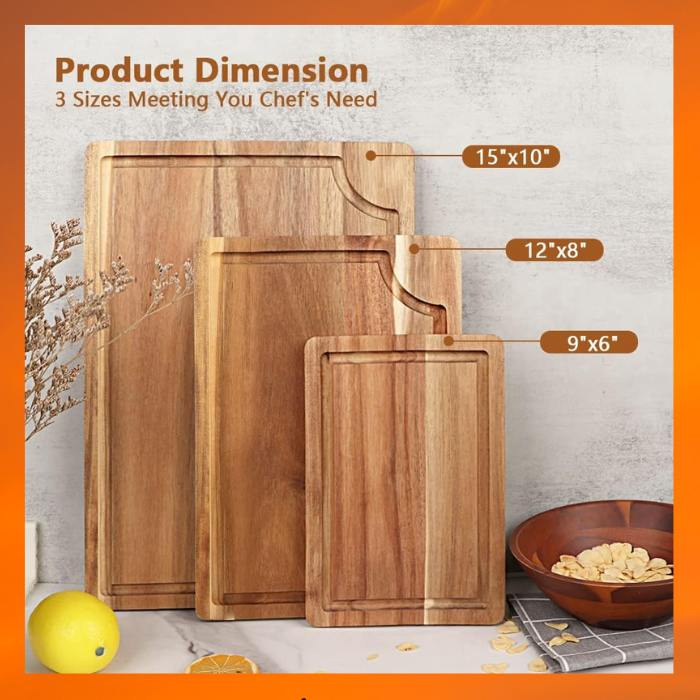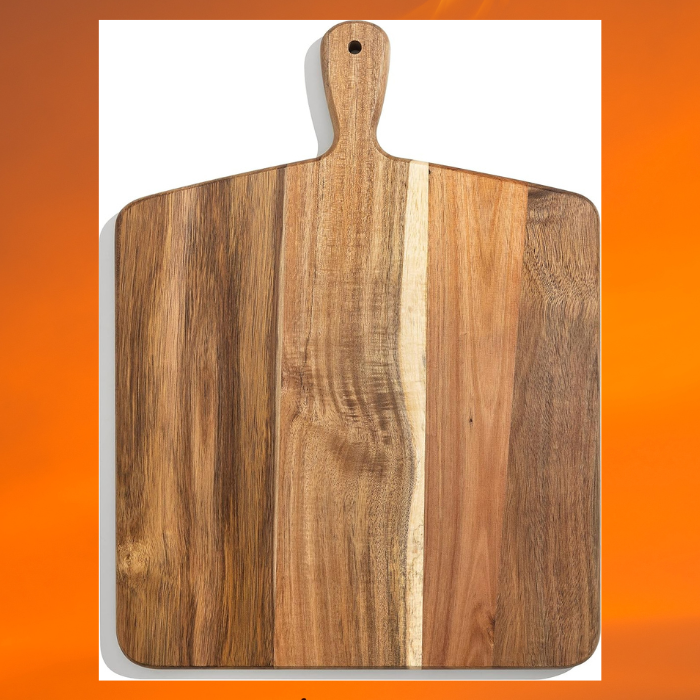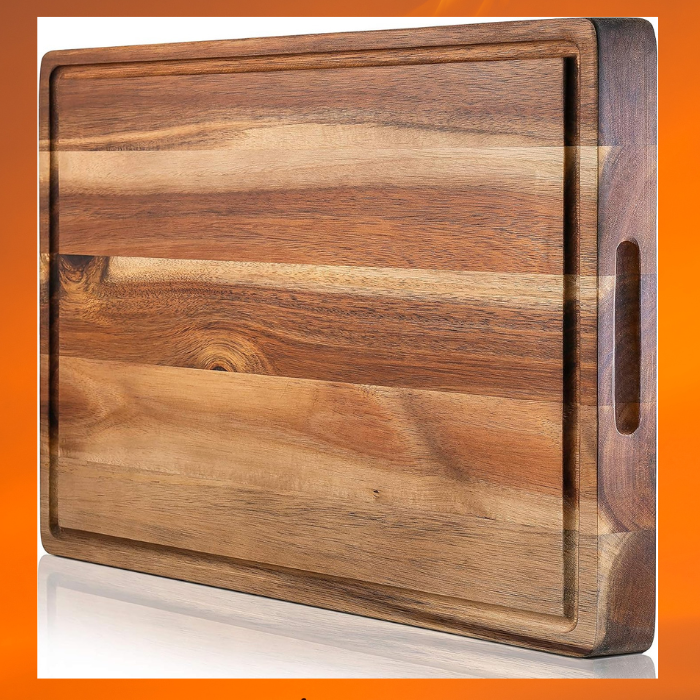Acacia Wood Cutting Board Pros And Cons. Acacia wood is a popular material for cutting boards due to its durability, aesthetics, and affordability.
What is acacia wood?
Acacia, also known as wattle, is a class of over 1000 species of trees and bushes, most of which are local to Australia, with a few species found in Africa, the Pacific Islands, Asia, and the Americas. Acacia wood is the hardwood that comes from the Acacia tree.
Each Acacia species has its possesses interesting characteristics. Be that as it may, for most species, the grain design and color run from medium to dull brown with appealing lines, whirls, and hitches. The wood is diffuse-porous, meaning it has equally dispersed pores throughout.


Density moreover shifts from species to species, but for the most part, Acacia is hard/tough. A few can be very overwhelming and have an amazing strength-to-weight proportion. Most commercial species utilized for furniture and carpentry are of medium density.
Pros of Acacia Wood
- Acacia is an exceedingly solid wood much appreciated for its thick grain and tight filaments, making it a perfect choice for cutting sheets. Its thickness makes a difference stand up to stains and distortion over time. Since acacia is a hardwood, it is safe to cut and rub from normal kitchen use.
- Acacia is accessible in an assortment of colors, from light to dull brown. The grain designs of the wood are moreover very alluring, frequently appearing whirls and lines, counting knots.
- Acacia cutting sheets are moderately simple to keep up. All they require is normal hand washing and oiling, which makes a difference keep the wood looking its best.
- An acacia wood cutting board is simple on blades. It is difficult sufficient to anticipate cut marks from shaping on the board.
Cons of Acacia Wood
- Acacia wood is very overwhelming. If you require an expansive board, it can be a bother to move it.
- Scratches that go against the grain of acacia wood are very troublesome to repair
- The high cost of acacia wood makes it a costly alternative for cutting boards.
- Acacia is an exceptionally intriguing wood, which implies it is not promptly accessible for the cutting board market
- Introduction to discuss and light causes an obscuring impact on acacias. Steadily, it loses its light color and changes to a darker color that may not be attractive
- The grain structure of acacia wood is eccentric. A few words may have hitches or imperfections, whereas others may have straight grains.
Acacia Wood vs. Other Cutting Board Materials
How does acacia compare to other materials when it comes to cutting sheets? Whereas acacia is an amazing choice, there are other materials to consider.
Acacia vs. Maple
Acacia and maple are hardwoods, so they are strong cutting sheets. Both materials are safe from dampness and stains, making them simple to keep up. Depending on the thickness of the fabric, an acacia cutting board will be heavier than a maple one.


Maple doesn’t have the spoil resistance of acacia, so if you take it off it is clammy for as well long, as it may begin to spoil. When torn between the two, numerous individuals select acacia.
Acacia vs. Plastic
Plastic is one of the cheaper alternatives for a cutting board. It’s less likely to gloom your blades and the fabric is non-porous, making it less demanding to clean than an acacia cutting board.
However, the fabric is inclined to scratches and scratches, which can trap microscopic organisms underneath the surface. Plastic wood cutting sheets too need the “self-healing” properties. Subsequently, with delayed utilization, they get to be so recolored that it gets to be a challenge to sanitize them.
The toughness of acacia makes it a great choice for eco-conscious clients. Not at all like plastic, acacia is biodegradable, making it way better for the environment.
Acacia vs. Glass
Glass cutting sheets are a well-known choice since they are smooth and present-day. They don’t recolor effortlessly, are simple to clean, and don’t effortlessly harbor odors or microscopic organisms. These highlights make glass cutting sheets a few of the healthiest.
However, they are not as strong as acacias and can chip or break effortlessly. Also, glass-cutting sheets gloom your kitchen blades quicker than strong wood choices. Glass-cutting sheets make irritating clamors when utilized with things that acacia sheets don’t.
Food Safety and Antibacterial Properties
Food safety is very important in the kitchen. Acacia wood cutting boards have antibacterial properties that make the kitchen safe. Their natural antimicrobial properties come from the chemical makeup of the wood. This makes acacia a top choice for those who care about their health.
Natural Antimicrobial Properties
Acacia wood stops harmful bacteria like salmonella and E. coli from growing. It contains natural compounds like tannins that fight bacteria. These compounds break down the cell membranes of bacteria, stopping them from spreading.
Food-Grade Certification Standards
Many acacia wood cutting boards are certified as food-grade. This means they are safe for food preparation. Look for these certifications when choosing an antibacterial cutting board that meets food safety standards.
Acacia wood is a top choice for kitchen hygiene. It has natural antimicrobial properties and is food-grade certified. Using an acacia cutting board means you can safely prepare food, knowing it is protected from harmful bacteria.
Acacia Wood Cutting Board Maintenance Tips
It is important to keep your acacia wood cutting board in great shape. This board lasts longer and looks beautiful. With a few simple steps, you can keep your wooden board looking and working at its best.
Cleaning and Caring for Your Acacia Board
It is essential to clean your acacia wood cutting board often. This keeps it clean and stops bacteria from growing. Use a mild, food-safe soap and warm water. Stay away from harsh cleaners that can damage the wood.
Gently scrub the board, especially in the grooves and crevices. Then, rinse it thoroughly and dry it with a towel. This stops water damage.
Oiling and Conditioning
It is important to oil your acacia wood to keep it moist. Use a food-grade oil like mineral oil, walnut oil, or a cutting board conditioner. Rub the oil into the wood, focusing on the edges and dry spots.
Let the oil soak in for 30 minutes. Then, buff the board with a clean, dry cloth.
Environmental Impact and Sustainability
Choosing an eco-friendly cutting board means looking at the environmental impact of the material. Acacia wood is a top pick for sustainable kitchen tools. It has special qualities that set it apart.


Cutting acacia wood has a lower environmental impact than some hardwoods. Acacia trees grow quickly, reaching maturity in 5-10 years. This rapid growth helps to conserve natural resources, helping to conserve natural resources.
- Acacia wood comes from managed plantations, ensuring a steady supply without damaging old-growth forests.
- Making acacia cutting boards typically results in little waste. Offcuts and sawdust are often reused.
- Acacia is strong and long-lasting, making eco-friendly cutting boards last longer and require fewer replacements.
Compared to plastic or bamboo, acacia wood is a greener choice. Its natural qualities and careful harvesting make it a top pick for eco-conscious shoppers.
Acacia wood cutting boards are a smart choice for the environment. By choosing an eco-friendly cutting board made from this wood, you are helping the planet. You will also get a durable and long-lasting product.
Best Uses for Acacia Wood Cutting Boards
Acacia wood cutting boards are known for their versatility. They are perfect for any kitchen. Their unique grain pattern and natural durability make them great for many tasks.
These boards are perfect for chopping, slicing, and dicing. They work well with fresh produce, meat, and cheese. Their hardness and scratch resistance mean they last a long time.


Acacia wood boards are also great for serving and presentation. Their natural beauty and grain pattern are perfect for displaying gourmet foods. They are easy to clean, making them a great addition to any kitchen.
Flexible Cutting Board Applications
Chopping new natural products and vegetables
- Cutting meat, angle, and cheese
- Dicing herbs and spices
- Serving as a charcuterie or cheese board
- Showing heated products and desserts
- Pairs as a trivet or hot plate
How to Select the Right Acacia Cutting Board
Finding the idealize acacia wood cutting board for your kitchen is a keen choice. It matters whether you are a prepared chef or fair beginning. Knowing what to see for makes a difference you discover a board that fits your cooking fashion and keeps going for a long time.
Acacia Wood Cutting Board Pros And Cons-Conclusion
Acacia wood cutting board is an incredible choice for the kitchen. It looks lovely and lasts a long time. It culminates for those who adore to cook and need something special.
It is not fair approximately looks; it is exceptionally strong. This makes it an awesome expansion to any kitchen. It is too secure to utilize since it is food-grade and has antimicrobial properties.
Choosing an Acacia Wood Cutting Board implies considering almost all its benefits and any downsides. You may be required to clean it once in a while or it may take a toll a small more. But, if you weigh the stars and cons, it seems to be an extraordinary choice for you.

